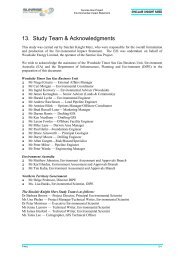Appendix D Terrestrial and Aquatic Biodiversity - Environment ...
Appendix D Terrestrial and Aquatic Biodiversity - Environment ...
Appendix D Terrestrial and Aquatic Biodiversity - Environment ...
You also want an ePaper? Increase the reach of your titles
YUMPU automatically turns print PDFs into web optimized ePapers that Google loves.
4.2 L<strong>and</strong> Systems<br />
Seven l<strong>and</strong> systems fall within the MLA areas, however only three are located in the proposed mining zones,<br />
including the Bukalara (Asb), Frog (Taf), <strong>and</strong> McArthur (Tam) l<strong>and</strong> systems (Figure 12). More detailed<br />
descriptions of l<strong>and</strong> systems are provided in Chapter 3 of the EIS document.<br />
4.3 Vegetation Surveys<br />
4.3.1 Summary of Vegetation Types<br />
Geology, l<strong>and</strong>form <strong>and</strong> soils have a dominant influence in shaping the vegetation types present. Broadly,<br />
five broadly defined vegetation types dominate the MLA areas, <strong>and</strong> these correlate with five main l<strong>and</strong> forms<br />
(described below <strong>and</strong> in Table 9).<br />
Acacia Woodl<strong>and</strong>s (Group A): Lancewood (Acacia shirleyi) open forest is found in fire shadow areas<br />
adjacent to Melaleuca swamps or at the base of low hills. Acacia shirleyi <strong>and</strong> Callitris intratropica <strong>and</strong> may<br />
also be found scattered within or around the edge of some vegetation types, most notably vegetation type 5.<br />
Eucalyptus/Corymbia Woodl<strong>and</strong>s over Hummock Grass (Group B): The well-drained rocky ridges,<br />
stony rises, <strong>and</strong> slight slopes adjoining these rocky areas (with well drained <strong>and</strong> s<strong>and</strong>ier soils) are dominated<br />
by Corymbia <strong>and</strong> Eucalyptus woodl<strong>and</strong>. In the northern part of the lease this woodl<strong>and</strong> type the understorey<br />
is dominated by Triodia species or is a mosaic of either a Hummock grass or Tussock grass, whereas in the<br />
southern part of the lease the understory is dominated by heath (e.g. Bossea <strong>and</strong> Jacksonia species).<br />
Woodl<strong>and</strong>s on the slight slopes transition into the other major habitat type Melaleuca open woodl<strong>and</strong>.<br />
Eucalyptus/Corymbia Woodl<strong>and</strong>s over Tussock Grass (Group C): Some small areas of Eucalyptus<br />
tectifica <strong>and</strong> E. pruinosa open woodl<strong>and</strong>s are patchily distributed on higher clay content soils usually not too<br />
distant from the rocky rises. Eucalyptus pruinosa may often be present in an eco-tone between upl<strong>and</strong><br />
Eucalyptus woodl<strong>and</strong> <strong>and</strong> Melaleuca citrolens open woodl<strong>and</strong> <strong>and</strong> in some case may be found within<br />
expanses of Melaleuca citrolens vegetation types. Occasional heavy clay areas amongst the Melaleuca<br />
plain support Excoecaria parvifolia woodl<strong>and</strong>s with a distinct heavy clay soil flora.<br />
Melaleuca Woodl<strong>and</strong>s (Group D): The Melaleuca open woodl<strong>and</strong>s occupy large parts of the MLA areas.<br />
The frequency <strong>and</strong> length of inundation varies as does the clay content of the soil. Melaleuca citrolens tend<br />
to occupy the sites with a greater clay content <strong>and</strong> for the most part drier or less inundated sites. Melaleuca<br />
viridiflora occupies both s<strong>and</strong>ier dry sites as well as wetter sites including billabongs <strong>and</strong> swamps.<br />
Wetl<strong>and</strong>s <strong>and</strong> Riparian Woodl<strong>and</strong>s (Group E): The diffuse drainage system of the Towns Creek dissects<br />
the main mine lease area <strong>and</strong> features floodplain, major <strong>and</strong> minor creek-lines as well as billabongs <strong>and</strong><br />
wetl<strong>and</strong>s. Asteromyrtus symphyocarpa is most common in vegetation types associated with these systems<br />
while Melaleuca viridiflora is also abundant. Eucalyptus <strong>and</strong> Corymbia are generally sparse <strong>and</strong> scattered<br />
within these l<strong>and</strong> forms but feature Corymbia polycarpa in the areas transitioning into a drier l<strong>and</strong>form. Also<br />
within these drainage areas Eucalyptus microtheca occurs on some of the more clayey floodplains <strong>and</strong> minor<br />
creek-lines <strong>and</strong> on the outer edge of wetl<strong>and</strong>s. Eucalyptus camaldulensis is common along the major creeklines<br />
but either scattered to absent throughout the other drainage areas.<br />
A total of 20 distinct vegetation units exist within the MLA areas (refer to Table 10 <strong>and</strong> Figure 14). Detailed<br />
descriptions are provided in <strong>Appendix</strong> D-9.<br />
Client: Western Desert Resources Ltd Page 51 of 150<br />
Doc No. DW120004-C0302-EIA-R-0036<br />
Doc Title: <strong>Appendix</strong> D – <strong>Terrestrial</strong> <strong>Biodiversity</strong> Technical Report



